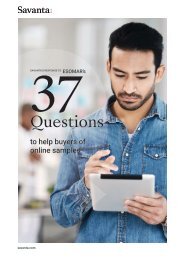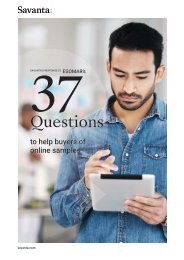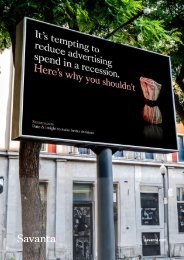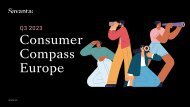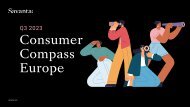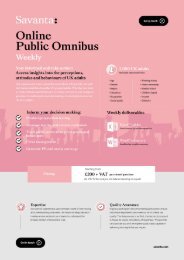Consumer Compass (Europe Report)
You also want an ePaper? Increase the reach of your titles
YUMPU automatically turns print PDFs into web optimized ePapers that Google loves.
Q3 2023<br />
<strong>Consumer</strong><br />
<strong>Compass</strong><br />
<strong>Europe</strong><br />
savanta.com
Savanta <strong>Consumer</strong> <strong>Compass</strong> <strong>Europe</strong> Q3 2023<br />
Contents<br />
Introduction 3<br />
Objectives & method 4<br />
<strong>Consumer</strong> <strong>Compass</strong> opinion 5<br />
<strong>Consumer</strong> confidence 6<br />
Spending habits & inflation 17<br />
Industry Spotlight: Fashion 19<br />
Industry Spotlight: Eating out 24<br />
Summary 32<br />
Final comment 33<br />
2
Savanta <strong>Consumer</strong> <strong>Compass</strong> <strong>Europe</strong> Q3 2023<br />
Introduction<br />
Welcome to our quarterly <strong>Europe</strong>an <strong>Consumer</strong> <strong>Compass</strong>.<br />
The goal of this work isn’t just to provide you with a snapshot<br />
of today’s consumers – it’s to help you understand how<br />
they’ll behave tomorrow.<br />
This report explores how consumers feel about their<br />
current and future spending habits, and examines their<br />
knowledge and awareness of topics that can be crucial to<br />
a brand’s success during periods of economic instability:<br />
sustainability, understanding of new technologies, and many<br />
others.<br />
This quarterly study surveys over 3,500 <strong>Europe</strong>an consumers<br />
in the Netherlands, France, Spain, Italy, Germany, the Nordics<br />
(Denmark, Norway, Sweden), and the UK and will<br />
deliver:<br />
» A <strong>Consumer</strong> Confidence Index (CCI) linked<br />
to current and future spend across markets<br />
» Analysis of sectors-at-risk<br />
» A profile of differences across <strong>Europe</strong>an<br />
markets.<br />
For brands that seek to be agile, proactive, and<br />
dynamic during this period of flux, the Savanta<br />
<strong>Europe</strong>an <strong>Consumer</strong> <strong>Compass</strong> is an invaluable<br />
tool to help marketers and product owners<br />
alike Make Better Decisions.<br />
Alex Ward-Booth<br />
Research Director | <strong>Consumer</strong><br />
3
Savanta <strong>Consumer</strong> <strong>Compass</strong> <strong>Europe</strong> Q3 2023<br />
Objectives & method<br />
Objectives<br />
» Measure <strong>Consumer</strong> Confidence (calculated based on<br />
3 main questions about projected confidence in the<br />
economy, personal finances, and job situations)<br />
» Understand & track current levels of confidence<br />
» Understand & track current spending habits and the<br />
impact of inflation<br />
» Assess which sectors may suffer in the upcoming<br />
quarter<br />
Method<br />
Online survey of n=3,500 consumers<br />
Fieldwork dates: September 2023<br />
Average interview length: 10 minutes<br />
Nationally representative sample (by market)<br />
» UK<br />
» France<br />
» Germany<br />
» Italy<br />
» Netherlands<br />
» Spain<br />
» The Nordics (Sweden, Norway, Denmark)<br />
4
Savanta <strong>Consumer</strong> <strong>Compass</strong> <strong>Europe</strong> Q3 2023<br />
<strong>Consumer</strong> <strong>Compass</strong> opinion<br />
Whilst there remain crucial variations between different markets, the consistent picture is that confidence, whilst<br />
improving, remains extremely fragile and brands will need to remain connected to the needs and concerns of<br />
consumers to benefit from the opportunities for growth which still exist<br />
Nikki Lavoie<br />
EVP | Strategy & Innovation<br />
Looking at the patterns, there are some notable observations:<br />
<strong>Consumer</strong> confidence remains fragile across<br />
<strong>Europe</strong>an markets<br />
This is reflected in the latest performance in Germany and<br />
the Netherlands this quarter; they had been the strongest<br />
markets in terms of consumer confidence but have had a<br />
challenging Q3; suggesting that the road to recovery will be<br />
a long one.<br />
The UK growth trajectory remains slow and steady although<br />
confidence remains low in this market, in particular around<br />
job security.<br />
<strong>Consumer</strong> spending remains focussed on the essentials<br />
With a continued focus on essential outgoings such as<br />
petrol, utility bills and groceries, households are continuing<br />
to restrict spending in discretionary sectors.<br />
Fashion and Eating out are sectors where consumers are<br />
making significant sacrifices in their spending. <strong>Consumer</strong>s<br />
remain active in both sectors but are adapting and<br />
becoming more strategic in their spending habits in order<br />
to make the most of restricted budgets.<br />
Opportunities remain for brands who can adapt to the<br />
new reality<br />
Whilst price and value remain key drivers for consumers,<br />
we believe that brands do not necessarily have to focus<br />
exclusively on lowering prices.<br />
Brands can influence spending by focusing on quality;<br />
providing consumers with longer-term value for money.<br />
Offers and promotions are also an important lever in<br />
bringing forward spending and attracting new shoppers<br />
into a brand.<br />
5
Savanta <strong>Consumer</strong> <strong>Compass</strong> <strong>Europe</strong> Q3 2023<br />
<strong>Consumer</strong> confidence<br />
6
Savanta <strong>Consumer</strong> <strong>Compass</strong> <strong>Europe</strong> Q3 2023<br />
Key insights by market<br />
Northern <strong>Europe</strong><br />
United Kingdom<br />
Germany<br />
Netherlands<br />
The Nordics<br />
Confidence in the UK remains on an<br />
upward trajectory with an increase in<br />
disposable income, though improvements<br />
are slow, and scores remain in negative<br />
territory.<br />
Perceptions of job security have<br />
improved significantly in the latest<br />
period, with 1 in 4 UK consumers saying<br />
that they feel better about their job<br />
situation than a year ago.<br />
However, 1 in 5 UK consumers currently<br />
classify themselves as ‘sufferers’ and this<br />
proportion has increased significantly in<br />
the last quarter. Whilst there are some<br />
signs of recovery in the UK, consumer<br />
confidence remains fragile overall.<br />
German consumers were amongst the<br />
most confident last quarter, but whilst<br />
confidence in some of the weaker<br />
economies has seen continued growth,<br />
<strong>Consumer</strong> Confidence Index (CCI) in<br />
Germany has reached a plateau this<br />
quarter.<br />
Just under half of consumers feel<br />
that Germany is worse off than other<br />
<strong>Europe</strong>an countries, and just 1 in 5 feel<br />
the government is doing a good job of<br />
handling the economy.<br />
However, the proportion of consumers<br />
who classify themselves as ‘squeezed’<br />
has declined significantly this quarter,<br />
with a growth in the more stable resilience<br />
groups (‘insulated’ and ‘cautious’),<br />
indicating that Germany is on the slow<br />
and steady road to recovery.<br />
Following strong Q2 scores, numerous<br />
metrics have seen more volatility for<br />
Dutch consumers this quarter, notably a<br />
5-point decrease in CCI and a 9% drop in<br />
perceptions of disposable income levels.<br />
Nonetheless, confidence remains<br />
comparatively strong in this market, with<br />
only Spain outperforming the Netherlands<br />
for CCI and perceptions of disposable<br />
income.<br />
Perceptions around personal job situation<br />
remain strongest in this market in<br />
reflection of the Netherlands having the<br />
second highest employment rate (82.3%),<br />
above all other markets tracked.<br />
Our three Nordic markets have seen<br />
sustained growth across all key metrics,<br />
including CCI, perceptions of disposable<br />
income and job situations.<br />
Subsequently, there has been a drop<br />
in the number of Nordic consumers<br />
categorising themselves as ‘squeezed’ or<br />
‘sufferers’, indicating a growing resilience<br />
and confidence amongst consumers in<br />
these markets.<br />
Nordic consumers also feel relatively<br />
confident about their personal job<br />
situation, only 1 in 5 feel that their job<br />
situation is worse than a year ago, the<br />
lowest of any market tracked.<br />
7
Savanta <strong>Consumer</strong> <strong>Compass</strong> <strong>Europe</strong> Q3 2023<br />
Key insights by market<br />
Southern <strong>Europe</strong><br />
Spain<br />
Spain’s <strong>Consumer</strong> Confidence Index<br />
(CCI) has reached its highest point<br />
this quarter, rising by an additional +3<br />
points. Young Spaniards are driving<br />
this confidence, with 39% expressing<br />
increased confidence compared to 27% of<br />
those aged 35 and above.<br />
Spain has also seen a significant increase<br />
in perceived disposable income, rising<br />
by 8 points to -5%, indicating greater<br />
financial flexibility and contributing to<br />
overall economic confidence.<br />
Despite positive indicators, Spaniards<br />
perceive their country as worse off<br />
compared to other <strong>Europe</strong>an countries,<br />
with 59% agreeing; hinting that economic<br />
progress can still be made.<br />
Italy<br />
Italy’s overall economic confidence<br />
has decreased this quarter, with only<br />
15% of people feeling more confident<br />
compared to a few months ago. Millennial<br />
Italians are particularly insecure about<br />
the economy, with only 36% reporting<br />
confidence.<br />
Perceptions of disposable income levels<br />
have remained steady with a slight<br />
increase in the last year, while Italians feel<br />
better about their job situation, with only<br />
34% agreeing theirs has gotten worse<br />
compared to the previous quarter.<br />
France<br />
France’s <strong>Consumer</strong> Confidence Index<br />
(CCI) has reached its highest level in<br />
the past year, driven primarily by young<br />
people, with 18-34-year-olds scoring 105<br />
compared to 35+ scoring 80.<br />
Perceptions of disposable income levels<br />
in France have also increased, although<br />
it remains the second lowest among the<br />
markets studied, at -25%.<br />
There has been a significant increase in<br />
those strongly agreeing that France is<br />
worse off than other <strong>Europe</strong>an countries,<br />
indicating that French consumers remain<br />
relatively pessimistic about the economic<br />
outlook.<br />
8
Savanta <strong>Consumer</strong> <strong>Compass</strong> <strong>Europe</strong> Q3 2023<br />
Confidence is<br />
returning slowly<br />
across most markets.<br />
<strong>Consumer</strong> Confidence Index (CCI)<br />
>100 = Positive<br />
100 = Neutral<br />
Savanta <strong>Consumer</strong> <strong>Compass</strong> <strong>Europe</strong> Q3 2023<br />
Though confidence in<br />
the economy remains<br />
fragile across markets,<br />
the UK has fallen back<br />
significantly this quarter<br />
strongly agree<br />
agree<br />
neither disagree/agree<br />
disagree<br />
strongly disagree<br />
Relative confidence in the economy<br />
Net — Sentiment (% agree – disagree)<br />
Significantly different at 95% confidence<br />
level from previous quarter<br />
-25 % -34 % -22 % -12 % -32 % -18 % -25 %<br />
5 % 5 % 5 % 6 % 3% 6 % 5 %<br />
21 % 15 % 19 % 23 % 16 % 21 % 21 %<br />
22 % 26 % 29 % 29 % 28 % 30 % 23 %<br />
32 % 36 % 29 % 24 % 38 % 29 % 29 %<br />
20 % 18 % 18 % 17 % 14 % 14 % 22 %<br />
Q: I feel more confident about the overall economic situation in the<br />
country than I did a couple of months ago: Please indicate how much you<br />
agree or disagree with the following statements. Total (c. 500 per market)<br />
France Italy Germany Spain Netherlands The Nordics UK<br />
10
Savanta <strong>Consumer</strong> <strong>Compass</strong> <strong>Europe</strong> Q3 2023<br />
Confidence in the<br />
economy has generally<br />
decreased, with only<br />
France and Spain<br />
seeing improvements<br />
from the last quarter<br />
0<br />
-4<br />
-8<br />
-12<br />
-16<br />
-20<br />
-24<br />
-28<br />
-32<br />
-36<br />
-40<br />
Relative confidence in the economy<br />
Net — Sentiment (% agree – disagree)<br />
Spain<br />
France<br />
-27 %<br />
-37 %<br />
Significantly different at 95% confidence<br />
level from previous quarter<br />
-23 % -12 %<br />
-33 % -25 %<br />
Young Spaniards drive the<br />
country’s high levels with<br />
39% agreeing they are<br />
more confident while only<br />
27% of 35+ agree<br />
--44<br />
Q1 2023 Q2 2023 Q3 2023<br />
Q: I feel more confident about the overall economic situation in the country than I did a couple of<br />
months ago: Please indicate how much you agree or disagree with the following statements.<br />
Total (c. 500 per market)<br />
11
Savanta <strong>Consumer</strong> <strong>Compass</strong> <strong>Europe</strong> Q3 2023<br />
Perceptions around<br />
disposable income<br />
overall continue to<br />
improve in all markets<br />
except the Netherlands,<br />
where trends have fallen<br />
back after a period of<br />
significant improvement.<br />
Q. On balance, which of these best describes the situation for your<br />
household now, compared to this time last year?<br />
Total (c. 500 per market)<br />
0<br />
-5<br />
-10<br />
-15<br />
-20<br />
-25<br />
-30<br />
-35<br />
-40<br />
-45<br />
Disposable income levels<br />
Q4 2022<br />
Q1 2023<br />
Q2 2023<br />
Q3 2023<br />
NET: Perceived Disposable Income (% more than last year – less than last year)<br />
-41 % -39 % -32 % -24 %<br />
Significantly different at 95% confidence<br />
level from previous quarter<br />
+8 +4 +1 +6 +8 -9 +11<br />
-25 % -26 % -18 % -5 % -16 %<br />
-14 % -13 %<br />
-18 %<br />
-24 % -27<br />
-30 % -29 % -27 % -29 %<br />
%<br />
-27<br />
-31 % -28 %<br />
%<br />
-33<br />
-32 % %<br />
-35 % -31 %<br />
UK France Italy Germany Spain Netherlands Nordics<br />
-15 %<br />
-1 %<br />
-10 %<br />
12
Savanta <strong>Consumer</strong> <strong>Compass</strong> <strong>Europe</strong> Q3 2023<br />
The Netherlands, Spain,<br />
and the Nordics all<br />
exhibit the highest level<br />
of confidence in their<br />
job situations. UK sees<br />
significant improvement<br />
vs. the previous quarter<br />
Current job situations<br />
Net — Situation (better – worse)<br />
Significantly different at 95% confidence<br />
level from previous quarter<br />
-19 % -10 % -14 % -1 % -2 % -1 % -6 %<br />
3 % 5 % 4 % 5 % 5 % 7 % 10 %<br />
13 % 12 % 12 % 19 % 20 % 16 % 15 %<br />
A lot better than last year<br />
A little better than last year<br />
About the same<br />
A little worse than last year<br />
A lot worse then last year<br />
48 % 56 % 54% 51 % 52 % 55 % 45 %<br />
25 % 17 % 18 %<br />
15 % 17 % 15 % 18 %<br />
Q: How would you describe your overall job situation right now?<br />
Base: Total (c. 500 per market)<br />
10 % 10 % 12 % 10 % 13<br />
6 % 7 %<br />
%<br />
France Italy Germany Spain Netherlands The Nordics UK<br />
13
Savanta <strong>Consumer</strong> <strong>Compass</strong> <strong>Europe</strong> Q3 2023<br />
We track the progress of four groups – defined<br />
by socio-economic attitudes – to go further than<br />
demographics to understand consumer resilience to<br />
economic downturns.<br />
Insulated Cautious Squeezed<br />
Sufferers<br />
I’m aware of the problems in the wider<br />
economy but it has not really affected<br />
me personally<br />
I’m being a bit more cautious about how<br />
much I spend and saving a bit more<br />
I’m taking action to buy cheaper brands<br />
and/or going to less expensive shops<br />
I’ve cut all of the expenditure that I<br />
can because I’m really worried about<br />
the future<br />
16 % 41 % 25 % 17 %<br />
Least affected<br />
Most affected<br />
Q: Which one of these statements describes you best?<br />
Base: Total EU (circa 3,000 per wave), UK (circa 2,000 per wave)<br />
14
Savanta <strong>Consumer</strong> <strong>Compass</strong> <strong>Europe</strong> Q3 2023<br />
The proportion of<br />
“squeezed” consumers<br />
has decreased in<br />
Germany, the Nordics<br />
and UK. In Germany<br />
and the Nordics, this is<br />
driven by “cautious” and<br />
“insulated” segments<br />
increasing this quarter,<br />
indicating a gradual<br />
increase in resilience<br />
Resilience groups – Q3 2023<br />
Sufferers<br />
Squeezed<br />
Cautious<br />
Insulated<br />
Significantly different at 95% confidence<br />
level from previous quarter<br />
19 % 16% 16 % 18 % 13 % 17 % 20 %<br />
27 % 25 % 25 % 21 % 29% 25 % 26 %<br />
40 % 47% 43% 43% 39 % 39 % 38 %<br />
14 % 12 % 16% 18 % 19 % 18 % 16 %<br />
Q: Which ONE of these statements describes you best?<br />
Base: Total (c. 500 per market)<br />
France Italy Germany Spain Netherlands The Nordics UK<br />
15
Savanta <strong>Consumer</strong> <strong>Compass</strong> <strong>Europe</strong> Q3 2023<br />
Spending habits<br />
& inflation<br />
16
Savanta <strong>Consumer</strong> <strong>Compass</strong> <strong>Europe</strong> Q3 2023<br />
We can map the impact of inflation against<br />
consumers’ net spend to understand which<br />
sectors are most at risk, and which are more<br />
protected.<br />
This quarter, most<br />
industries have<br />
remained in the<br />
same quartile, with<br />
fashion and eating out<br />
continuing to be our<br />
most affected sectors<br />
Impact of<br />
inflation<br />
Economic health by consumer sector<br />
Cost of living sector map<br />
Sacrificed<br />
Inflation impact high, spending much less<br />
Eating out<br />
Entertainment out of home<br />
Fashion<br />
DIY & home improvement<br />
Holidays<br />
Grooming & beauty<br />
Family days out<br />
Protected<br />
Inflation impact high but spending not impacted<br />
Eating in (take-aways)<br />
Groceries<br />
Utilities<br />
Petrol<br />
Insurance<br />
Alcohol (on-trade) In-home entertainment<br />
Alcohol (off-trade)<br />
Extra-curricular activities<br />
Phone contract<br />
Q. How significantly have recent price increases impacted your levels of<br />
spending in any of the following areas?<br />
Q. How much, if at all, have you changed your spending on the following,<br />
in the past year?<br />
Base: Total EU (circa 3,501 per wave)<br />
De-prioritised<br />
Gym<br />
Less affected<br />
Inflation impact low but spending still much less<br />
Inflation impact low, spending not impacted<br />
NET spend<br />
Note: Utility bills chart above shown axes as 'protected' with high impact of inflation and NET spend<br />
17
Savanta <strong>Consumer</strong> <strong>Compass</strong> <strong>Europe</strong> Q3 2023<br />
Industry Spotlight<br />
Sacrificed Sectors:<br />
Fashion<br />
18
Savanta <strong>Consumer</strong> <strong>Compass</strong> <strong>Europe</strong> Q3 2023<br />
More than half are cutting their fashion<br />
spending, with France and the UK cutting back<br />
most, reflecting their low confidence scores<br />
Have stopped<br />
spending on<br />
NET Spend<br />
of consumers across<br />
59 %<br />
10 %<br />
46 % markets have cut down on<br />
non-essential spending to<br />
save money, with fashion<br />
suffering the most<br />
49 %<br />
have spent less in this sector<br />
over the past 12 months.<br />
30 %<br />
2 %<br />
Q. Have you done any of the following in the last few months as a result of<br />
the rising inflation? | Q9_5. Fashion: How much, if at all, have you changed<br />
your spending on the following, in the past year?<br />
Base: Total (3,500) (c. 500 per market)<br />
Spending less on<br />
Spending the<br />
same on<br />
Spending more on<br />
Have never used/spent on<br />
9 % -50 %<br />
NET % stopped spending/spending less<br />
UK<br />
France<br />
The Nordics<br />
Italy<br />
Germany<br />
Netherlands<br />
Spain<br />
65 %<br />
64 %<br />
61 %<br />
59 %<br />
57 %<br />
55 %<br />
53 %<br />
19
Savanta <strong>Consumer</strong> <strong>Compass</strong> <strong>Europe</strong> Q3 2023<br />
There is a generational skew to fashion spending with older<br />
consumers more likely to have cut spending in this sector<br />
Fashion spend (L12M)<br />
By generation<br />
Spending more on<br />
Gen Alpha<br />
Gen Z<br />
Millennials<br />
Gen X<br />
Baby Boomers<br />
Silent Generation<br />
Spending the same on<br />
Spending less on<br />
Have stopped spending on Have never used/spent on<br />
NET Spend<br />
18 %<br />
34 % 33 % -26 %<br />
23 %<br />
30 %<br />
37 %<br />
2 % -22 %<br />
11 %<br />
30 % 48 %<br />
9 % 2 % -46 %<br />
-54<br />
6 % 31 % 51 %<br />
9 % 3 %<br />
%<br />
4 % 28 % 54 %<br />
12 % 2 % -61 %<br />
29 %<br />
11 % 4 %<br />
8 %<br />
53 % 11 %<br />
6 % -65 %<br />
Q. Fashion: How much, if at all, have you changed your spending on the following, in the past year?<br />
Base: Total (3,500), Gen Alpha, (172), Gen Z (302), Millennials (850), Gen X (979), Baby Boomers (1122), Silent Generation (75)<br />
*Caution – low base size<br />
20
Savanta <strong>Consumer</strong> <strong>Compass</strong> <strong>Europe</strong> Q3 2023<br />
We expect decreased<br />
spending to continue,<br />
though to a lesser<br />
extent with just 1 in 10<br />
saying they expect to<br />
spend more on fashion<br />
in the next 3 months<br />
Whilst we expect to see some small improvements<br />
in fashion spending over the next quarter,<br />
spending will remain in negative territory, with the<br />
majority continuing to cut back.<br />
Anticipated Spend<br />
Fashion (N3M)<br />
Anticipate stop spending on<br />
NET Spend<br />
-49 % -38 % -28 % -39 % -33 % -42 % -45 %<br />
14 % 14 % 15 %<br />
39 %<br />
47 %<br />
Anticipate spending less on<br />
Anticipate no change in<br />
my spending on this<br />
33 % 13 % 11 %<br />
Anticipate spending on more<br />
16 % 17 %<br />
35<br />
13 % % 35 %<br />
38 %<br />
42 % 39 % 36 %<br />
We expect spending to remain lowest in the UK<br />
and France.<br />
27 % 32 % 32 % 35 %<br />
12 % 15 % 20 % 11 % 12 % 9 % 9 %<br />
Q. Fashion: And how do you anticipate your spend on each of the following to change<br />
over the next 3 months (excl. don’t know)<br />
Base: Total (3,500) (c. 500 per market)<br />
France Italy Germany Spain Netherlands The Nordics UK<br />
21
Savanta <strong>Consumer</strong> <strong>Compass</strong> <strong>Europe</strong> Q3 2023<br />
The increase in inflation across numerous markets<br />
has driven the rise of second-hand, feeding<br />
consumers’ need for value and sustainability<br />
A surge in the use of charity shops<br />
In the UK, where confidence scores are lowest, charity<br />
shops store income grew 15.1% in Q1 2023 vs Q1 2022,<br />
with average daily transactions also growing 12.4%*<br />
demonstrating a shift in shopping behaviours, and a move<br />
away from the usual high street retailers.<br />
Over a third (37%) are still spending on fashion monthly,<br />
and a quarter (26%) bi-monthly, showing there is still an<br />
appetite for fashion, but consumers are more strategic in<br />
their spending.<br />
The tipping point of second-hand platforms<br />
Second-hand clothing apps have also become increasingly<br />
popular for both buying and selling as consumers try to<br />
make more money where they can and save on spending.<br />
Vinted, a global second-hand clothing app, has seen huge<br />
growth since 2021, from 1.2 million members to 8 million in<br />
2023**<br />
Value missions driving sustainable behaviour<br />
Not only does second-hand service the consumer need<br />
for greater value, it also has secondary benefits as it<br />
supplements the desire to shop more sustainably.<br />
Whilst price remains the biggest spending influencer<br />
across markets, around 2 in 5 still place weight on<br />
sustainability when shopping, hence there are multiple<br />
benefits to shopping second-hand.<br />
Q. Have you done any of the following in the last few months as a result of the rising inflation?<br />
Q. How important is the following when deciding which product/service to purchase when shopping?<br />
Base: Total (3,500) (c. 500 per market)<br />
* Source: https://www.thirdsector.co.uk/charity-shops-bounce-back-bumperfestive-sales-report/fundraising/article/1816591<br />
** Source: https://www.thedrum.com/news/2023/03/02/how-vinted-and-depopare-stepping-up-ad-spend-pre-loved-brands-tops-100m<br />
22
Savanta <strong>Consumer</strong> <strong>Compass</strong> <strong>Europe</strong> Q3 2023<br />
Industry Spotlight<br />
Sacrificed Sectors:<br />
Eating out<br />
23
Savanta <strong>Consumer</strong> <strong>Compass</strong> <strong>Europe</strong> Q3 2023<br />
Eating out has also<br />
suffered due to the<br />
economic downturn,<br />
with net spending levels<br />
down across all markets<br />
Eating Out spend (L12M) Net Spend:<br />
% spending more - spending less<br />
Q4 2022<br />
Q1 2023<br />
Q2 2023<br />
Q3 2023<br />
As with fashion, spending on Eating Out has typically decreased by<br />
most in markets with poor confidence levels – the UK & France.<br />
One exception is the Nordics, where spend is low on Eating Out,<br />
but confidence is high overall. However, spending on Eating Out in<br />
this market has fluctuated minimally and the perceived impact of<br />
inflation is low, suggesting that low spend is a result of social and<br />
cultural trends, rather than the economic environment<br />
All markets have seen improvements in spend over the last 12<br />
months, though levels remain negative<br />
-40<br />
-45<br />
-50<br />
-55<br />
-60<br />
-65<br />
-56 % -55 % -42 % -42 %<br />
-48 % -50 % -50 % -51 % -53 %<br />
-47 %<br />
-50 % -52<br />
-53 % % -56<br />
-57 % -57 % % -57 % -58<br />
-57 % -59 %<br />
% -59 %<br />
-60 % -58 %<br />
-60 % -63 %<br />
-64 %<br />
-57 %<br />
-61 %<br />
Q Eating out: How much, if at all, have you changed your spending on the<br />
following, in the past year?<br />
Base: Total (3,500) (c. 500 per market per wave) *UK – Q4 ‘22, Q1 ’23, Q2<br />
‘23 (c.2000)<br />
Italy Germany Spain Netherlands UK France Nordics<br />
24
Savanta <strong>Consumer</strong> <strong>Compass</strong> <strong>Europe</strong> Q3 2023<br />
Of the non-essential sectors, impact of inflation is<br />
highest for Eating Out, hence it is unsurprising we<br />
continue to see consumers sacrifice this luxury<br />
Impact of inflation on spending levels (non-essentials sectors)<br />
France<br />
83 %<br />
100<br />
90<br />
80<br />
70<br />
60<br />
50<br />
40<br />
30<br />
20<br />
10<br />
0<br />
75 %<br />
73 % 73 % 71 % 68 % 67 % 67 % Germany<br />
Italy<br />
Spain<br />
UK<br />
Netherlands<br />
The Nordics<br />
82 %<br />
78 %<br />
73 %<br />
72 %<br />
69 %<br />
68 %<br />
Eating out Fashion Holidays Eating in Personal<br />
grooming and<br />
beauty<br />
Entertainment<br />
outside the<br />
home<br />
Days out with<br />
the family<br />
Q. Eating out: How significantly have recent price increases impacted your levels of spending in any of the following areas?<br />
Base: Total (3,500) (c.500 per market)<br />
25
Savanta <strong>Consumer</strong> <strong>Compass</strong> <strong>Europe</strong> Q3 2023<br />
40 % 42 %<br />
As with fashion,<br />
Anticipated Spend – Eating Out (N3M)<br />
spending will remain in<br />
negative territory next<br />
quarter, with just under<br />
half anticipating to cut<br />
down their spending 27 % 29 % 28 % 30 % 34 %<br />
NET spend<br />
% spending more - spending less/stopped spending<br />
-47 % -37 % -26 % -43 % -29 % -40 % -39 %<br />
Anticipate a spending stop<br />
Anticipate spending less<br />
Anticipate no change in spending<br />
Anticipate spending more<br />
18 % 17 % 22 % 21 % 15 % 19 % 19 %<br />
40 % 33 % 23 % 34 % 27 % 28 % 30 %<br />
10 % 13 % 20 % 11 % 12 % 7 % 10 %<br />
Q: Which ONE of these statements describes you best?<br />
Base: Total (c. 500 per market)<br />
France Italy Germany Spain Netherlands Nordics UK<br />
26
Savanta <strong>Consumer</strong> <strong>Compass</strong> <strong>Europe</strong> Q3 2023<br />
However, eating out frequency is relatively high suggesting<br />
social drivers maintain appetite for this activity<br />
6 in 10 consumers (60%) say they are still eating out at least once a month. Therefore the lower claimed spend levels in this sector suggest that it has not been entirely sacrificed but, as<br />
with fashion, consumers are choosing when to spend their money more carefully.<br />
This reveals that consumers are still active in this space and open to being influenced by brands who can understand and leverage the economic context effectively.<br />
Monthly spend<br />
% spending least once a month (by category)<br />
100<br />
90<br />
80<br />
70<br />
60<br />
50<br />
40<br />
30<br />
73 % 70 % 69 % 65 % 60 % 59 % 54 % 53 % 51 % 46 % 42 % 38 % 33 % 18 %<br />
In-home<br />
entertainment<br />
Eating in<br />
Alcohol<br />
at home<br />
Gym<br />
Eating out<br />
Insurance<br />
Alcohol out<br />
Extra-curricular<br />
activities<br />
Personal<br />
grooming<br />
Entertainment<br />
out of home<br />
Days out with<br />
the family<br />
Fashion<br />
DIY/Home<br />
improvements<br />
Holidays<br />
Q: And on average, how often do you spend on each of the below?<br />
Base: Total (3,500) (c. 500 per market)<br />
27
Savanta <strong>Consumer</strong> <strong>Compass</strong> <strong>Europe</strong> Q3 2023<br />
Support consumers and drive loyalty<br />
<strong>Consumer</strong>s want to continue to socialise through eating out<br />
occasions but are also looking for ways to make their budgets<br />
stretch further. This provides an opportunity for brands in the<br />
sector to identify new ways to grow and retain their customer base.<br />
Loyalty programmes can offer value for money<br />
for consumers, whilst also creating further<br />
opportunities for brands to connect with<br />
their customers, foster loyalty, and provide<br />
personalised experiences.<br />
How can you utilise<br />
loyalty programmes to<br />
drive advocacy amongst<br />
your customers?<br />
28
Savanta <strong>Consumer</strong> <strong>Compass</strong> <strong>Europe</strong> Q3 2023<br />
Whilst “price/<br />
value” is key across<br />
all categories, other<br />
purchase drivers<br />
such as “quality” and<br />
“durability” also remain<br />
critical. These drivers<br />
can allow brands to<br />
offer value for money<br />
without a focus solely<br />
on price point<br />
Purchase Drivers - rated 8-10/10<br />
Significantly different at 95% confidence<br />
level from previous quarter<br />
Eu average Q4 2022 Q1 2023 Q2 2023 Q3 2033<br />
Price/value 75 % 74 % 71 % 72 %<br />
Quality 72 % 71 % 69 % 67 %<br />
Durability 70 % 67 % 65 % 63 %<br />
Offers/promotions 69 % 67 % 65 % 65 %<br />
Reliability 69 % 68 % 64 % 63 %<br />
Convenience 54 % 51 % 51 % 47 %<br />
Returns/cancellation policy 53 % 50 % 48 % 45 %<br />
Sustainability 45 % 42 % 43 % 41 %<br />
Brands’ ethics & values 38 % 36 % 36 % 34 %<br />
Brand reputation 39 % 37 % 36 % 36 %<br />
Q. On a scale of 1 to 10, where 10 is ‘extremely important’ and 1 is ‘extremely<br />
unimportant’, how important is the following when deciding which product/service<br />
to purchase when shopping?<br />
Base: Total EU (c. 3501 per wave)<br />
Packaging 30 % 28 % 29 % 29 %<br />
29
Savanta <strong>Consumer</strong> <strong>Compass</strong> <strong>Europe</strong> Q3 2023<br />
Focusing on value for money instead<br />
of absolute price point.<br />
We know that shoppers appreciate good value, and an occasional<br />
bargain. But when brands focus exclusively on price point at<br />
the expense of quality, there can be a risk of impacting brand<br />
perceptions<br />
Levi’s provides a great example of a quality message in their<br />
“Greatest Story ever worn” campaign; where they focus on the<br />
quality and longevity of their products so that consumers reflect on<br />
the broader value equation when considering what to buy<br />
How can your brand<br />
provide consumers with a<br />
sense of value for money,<br />
without competing solely<br />
on price?<br />
30
Savanta <strong>Consumer</strong> <strong>Compass</strong> <strong>Europe</strong> Q3 2023<br />
Summary<br />
1. Impact of inflation remains high across necessary spend categories (e.g., grocery, bills) so<br />
consumers continue to cut back and deprioritise spending on non-essential sectors.<br />
Across markets, all non-essential sectors fall in to the deprioritised or sacrificed categories highlighting that<br />
consumers are continuing to cut back on spending and change their behaviours.<br />
Inflation impacts grocery the most, presenting an ongoing challenge for supermarket retailers.<br />
2. Eating out and fashion continue to suffer the most, with both of these categories being<br />
sacrificed. However, frequency isn’t necessarily shrinking as consumers spend more<br />
strategically.<br />
These two sectors have seen the highest proportion of consumers reducing their spend across markets but<br />
frequency of spend is still relatively high; 3 in 5 are eating out on a monthly basis, whilst just under two thirds are<br />
making fashion purchases at least every other month, demonstrating there is still appetite within both of these<br />
sectors.<br />
<strong>Consumer</strong>s have adapted and become savvier in their ways of spending e.g., second-hand clothing has become a<br />
popular solution to tackling climbing prices on the high street.<br />
3. Price and value remain the biggest purchase drivers as consumers continue to face economic<br />
challenges, but other factors can be leveraged by brands to encourage consumers to spend<br />
with them.<br />
Brands can look outside a narrow focus on prices, promoting instead the quality and durability of their products to<br />
drive value for money perceptions amongst consumer.<br />
31
Savanta <strong>Consumer</strong> <strong>Compass</strong> <strong>Europe</strong> Q3 2023<br />
Final comment<br />
In the challenging trading environment we currently face, it is critical for brands to continue to focus on<br />
understanding their consumers so that they can continue to succeed.<br />
Will Blackett<br />
EVP | <strong>Consumer</strong><br />
Strengthen Brand connection<br />
Optimise the path to purchase<br />
Innovate and renovate<br />
How can you ensure that you establish a<br />
meaningful link for your brand into the lives<br />
of consumers so that your current customers<br />
remain loyal and non-customers can be<br />
converted?<br />
How can you ensure that your products and<br />
services are visible and available where it matters<br />
through touchpoint optimisation and channel<br />
strategy?<br />
How can you ensure that your range is relevant to<br />
the ever changing needs of consumers<br />
32
Savanta <strong>Consumer</strong> <strong>Compass</strong> <strong>Europe</strong> Q3 2023<br />
Want to find out more?<br />
Get in touch<br />
Will Blackett<br />
EVP | <strong>Consumer</strong><br />
Nikki Lavoie<br />
EVP | Strategy & Innovation<br />
Oliver Warren<br />
Senior Director | EMEA<br />
william.blackett@savanta.com<br />
nikki.lavoie@savanta.com<br />
oliver.warren@savanta.com<br />
savanta.com<br />
33
etter.decisions@savanta.com<br />
UK | +44 (0) 20 7632 3434 EU/NL | +31 (20) 809 3812 US | +1 (917) 768 2710<br />
This report has been prepared for general interest only and no representation or warranty (express or implied) is given as to the accuracy or completeness. Of the information contained in it, to the extent<br />
permitted by law, Savanta Limited and its employees and agents do not accept or assume any liability, responsibility or duty of care for any consequences of anyone relying on the information contained in this<br />
report or for any decision based on it. We expressly reserve all rights in and to the name “Savanta”, our logo, service marks, trading names and/or trademarks. © 2023 Savanta Limited. All rights reserved.<br />
savanta.com







